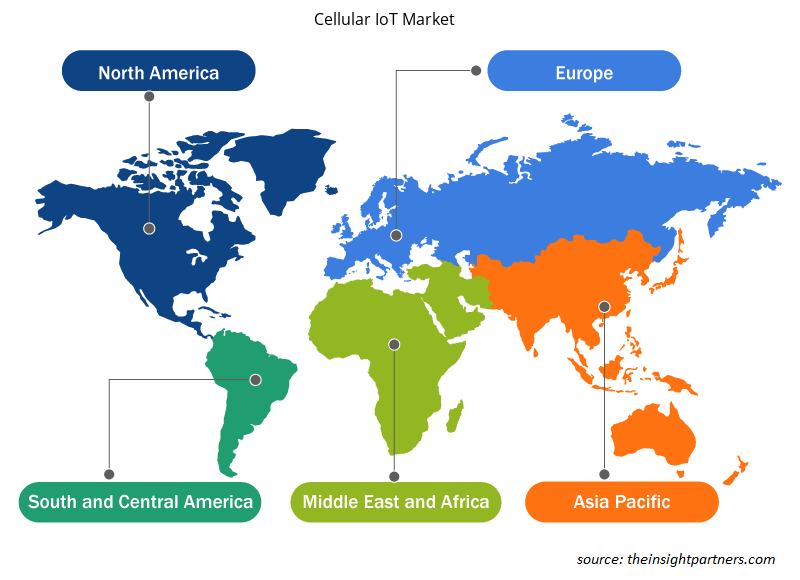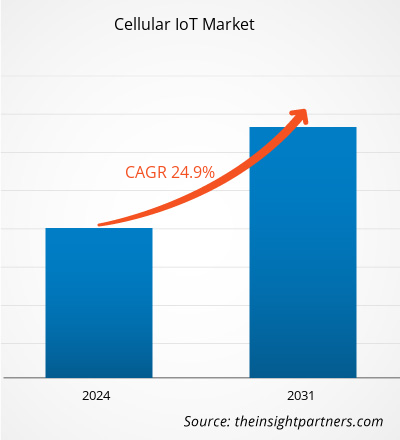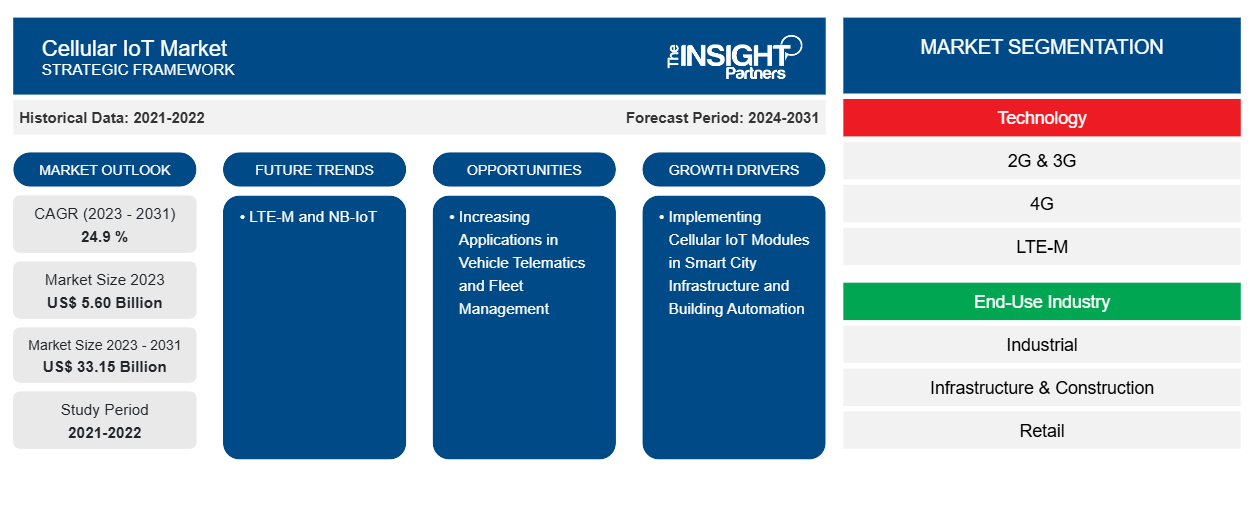من المتوقع أن يصل حجم سوق إنترنت الأشياء الخلوي إلى 33.15 مليار دولار أمريكي بحلول عام 2031 من 5.60 مليار دولار أمريكي في عام 2023. ومن المتوقع أن يسجل سوق إنترنت الأشياء الخلوي معدل نمو سنوي مركب بنسبة 24.9٪ في الفترة 2023-2031. يتم استخدام وحدات إنترنت الأشياء الخلوية بشكل متزايد في البنية التحتية للمدن الذكية وأتمتة المباني، وكذلك في الأتمتة الزراعية ومراقبة البيئة، مما يدفع توسع السوق.
تحليل سوق إنترنت الأشياء الخلوي
يمكن لإنترنت الأشياء الخلوي إدارة المتطلبات الحساسة والفريدة للتطبيقات والإعدادات المعقدة، فضلاً عن الاحتياجات الأساسية لسوق إنترنت الأشياء الضخم. هناك نوعان رئيسيان من إنترنت الأشياء الخلوي: التطور الطويل الأمد للآلات (LTE-M) وإنترنت الأشياء ضيق النطاق (NB-IoT). تشمل أمثلة تطبيقات NB-IoT وLTE-M الزراعة الدقيقة والمدن الذكية وآلات البيع ومراقبة الأساطيل وغيرها، وكلها تقدم آفاقًا كبيرة لحصة سوق إنترنت الأشياء الخلوي. تتطلب هذه التطبيقات اتصالات بعيدة المدى موثوقة وآمنة.
نظرة عامة على سوق إنترنت الأشياء الخلوي
إن وجود الدول سريعة النمو، والقبول المتزايد للتكنولوجيات المتقدمة، والعدد المتزايد من الأجهزة المتصلة هي من بين الأسباب الرئيسية التي من المتوقع أن تدفع التوسع العالمي لإنترنت الأشياء الخلوي. ومن المتوقع أن ينمو سوق إنترنت الأشياء الخلوي العالمي بسبب زيادة الرقمنة والأتمتة في الصناعات مثل السيارات والتصنيع والطاقة والمرافق. ومن المتوقع أن يؤدي الطلب المتزايد على تغطية الشبكة الموسعة، والميل المحسن نحو تطوير الأعمال خارج النطاق العريض المحمول ، والحاجة إلى استيعاب عدد كبير من الأجهزة المتصلة بين الشركات في جميع أنحاء العالم إلى دفع حجم سوق إنترنت الأشياء الخلوي.
قم بتخصيص هذا التقرير ليناسب متطلباتك
ستحصل على تخصيص لأي تقرير - مجانًا - بما في ذلك أجزاء من هذا التقرير، أو تحليل على مستوى الدولة، وحزمة بيانات Excel، بالإضافة إلى الاستفادة من العروض والخصومات الرائعة للشركات الناشئة والجامعات
-
احصل على أهم اتجاهات السوق الرئيسية لهذا التقرير.ستتضمن هذه العينة المجانية تحليلاً للبيانات، بدءًا من اتجاهات السوق وحتى التقديرات والتوقعات.
محركات وفرص سوق إنترنت الأشياء الخلوية
تنفيذ وحدات إنترنت الأشياء الخلوية في البنية التحتية للمدينة الذكية وأتمتة المباني لصالح السوق
إن بناء المدن الذكية وأتمتة البنية التحتية هما أهم انتشارين عموديين لوحدات إنترنت الأشياء الخلوية، حيث تمثلان غالبية إيرادات سوق إنترنت الأشياء الخلوية. يمكن للأجهزة التي تعمل بالبطاريات الآن الاتصال بالإنترنت بفضل تقنيات إنترنت الأشياء الخلوية الناشئة مثل NB-LTE-M وNB-IoT و5G. تربط هذه التقنيات الأجهزة بشكل أكثر فعالية من تقنيات 2G و3G الحالية، بما في ذلك مواقف السيارات الذكية وإضاءة الشوارع الذكية. إن مصابيح الشوارع وأجهزة استشعار ومراقبة حركة المرور وأجهزة إدارة القمامة وأجهزة إدارة مواقف السيارات ليست سوى عدد قليل من الاستخدامات العديدة لإنترنت الأشياء الخلوية في المدن الذكية. تعد تحسينات البنية التحتية الحديثة أولوية قصوى للحكومات في جميع أنحاء العالم، ويتم إطلاق العديد من المشاريع التجريبية لتحقيق هذا الهدف.
زيادة التطبيقات في مجال الاتصالات عن بعد بالمركبات وإدارة الأسطول
تعد أنظمة الاتصالات عن بعد الخاصة بالمركبات من أهم التطبيقات الجديدة لإنترنت الأشياء الخلوي، حيث تعمل على تعزيز الأداء والاتصال مع الاستفادة من موارد المؤسسة. ومن المتوقع أن يولد اتجاه نشر أنظمة الاتصالات عن بعد في المركبات التي تسير على الطرق الوعرة والطرق السريعة إمكانات تطوير كبيرة. عندما يتعلق الأمر بالمعدات التي تسير على الطرق الوعرة، مثل الرافعات والحفارات، مع عدد محدود من المحترفين، فإن الوقت أمر بالغ الأهمية. يعد تنفيذ حلول إنترنت الأشياء والاتصالات عن بعد ضروريًا لمراقبة المعدات والأصول على الطرق. ونتيجة لذلك، يقوم مزودو حلول الاتصالات عن بعد بدمج وحدات إنترنت الأشياء الخلوية في عروض منتجاتهم، مما يسهل على مديري الأساطيل ومصنعي المركبات التي تسير على الطرق الوعرة جمع وتحليل البيانات الميدانية والاتجاهات والمشكلات.
تقرير تحليل تجزئة سوق إنترنت الأشياء الخلوي
إن القطاعات الرئيسية التي ساهمت في اشتقاق تحليل سوق إنترنت الأشياء الخلوي هي التكنولوجيا والنشر وصناعة الاستخدام النهائي والمستخدم النهائي.
- استنادًا إلى التكنولوجيا، يتم تقسيم سوق إنترنت الأشياء الخلوي إلى 2G و 3G و 4G و LTE-M و NB-IoT و 5G.
- استنادًا إلى صناعة الاستخدام النهائي، يتم تقسيم سوق إنترنت الأشياء الخلوي إلى الصناعة والبنية التحتية والبناء وتجارة التجزئة والإلكترونيات الاستهلاكية والسيارات والنقل والطاقة والمرافق والرعاية الصحية وغيرها.
تحليل حصة سوق إنترنت الأشياء الخلوية حسب المنطقة الجغرافية
ينقسم النطاق الجغرافي لتقرير سوق إنترنت الأشياء الخلوي بشكل أساسي إلى خمس مناطق: أمريكا الشمالية، وآسيا والمحيط الهادئ، وأوروبا، والشرق الأوسط وأفريقيا، وأمريكا الجنوبية/أمريكا الجنوبية والوسطى. تمتلك دول مثل الهند والصين عددًا كبيرًا من تجار أشباه الموصلات. علاوة على ذلك، من المتوقع أن يؤدي دخول شركات التكنولوجيا المتزايد إلى المنطقة، بالإضافة إلى زيادة الاستثمار في تقنيات إنترنت الأشياء، إلى دفع توسع السوق. تهتم الحكومات في جميع أنحاء الدول الآسيوية، مثل الهند، أيضًا بصناعة إنترنت الأشياء الخلوية وتنفذ عددًا من مشاريع البنية التحتية الذكية. دعت حكومات الهند واليابان والصين وكوريا وماليزيا وسنغافورة إلى سياسات إنترنت الأشياء الخلوية الوطنية.
رؤى إقليمية حول سوق إنترنت الأشياء الخلوي
لقد قام المحللون في Insight Partners بشرح الاتجاهات والعوامل الإقليمية المؤثرة على سوق إنترنت الأشياء الخلوية طوال فترة التنبؤ بشكل شامل. يناقش هذا القسم أيضًا قطاعات سوق إنترنت الأشياء الخلوية والجغرافيا في جميع أنحاء أمريكا الشمالية وأوروبا ومنطقة آسيا والمحيط الهادئ والشرق الأوسط وأفريقيا وأمريكا الجنوبية والوسطى.

- احصل على البيانات الإقليمية المحددة لسوق إنترنت الأشياء الخلوي
نطاق تقرير سوق إنترنت الأشياء الخلوي
| سمة التقرير | تفاصيل |
|---|---|
| حجم السوق في عام 2023 | 5.60 مليار دولار أمريكي |
| حجم السوق بحلول عام 2031 | 33.15 مليار دولار أمريكي |
| معدل النمو السنوي المركب العالمي (2023 - 2031) | 24.9% |
| البيانات التاريخية | 2021-2022 |
| فترة التنبؤ | 2024-2031 |
| القطاعات المغطاة |
حسب التكنولوجيا
|
| المناطق والدول المغطاة |
أمريكا الشمالية
|
| قادة السوق وملفات تعريف الشركات الرئيسية |
|
كثافة اللاعبين في سوق إنترنت الأشياء الخلوي: فهم تأثيرها على ديناميكيات الأعمال
يشهد سوق إنترنت الأشياء الخلوي نموًا سريعًا، مدفوعًا بالطلب المتزايد من المستخدم النهائي بسبب عوامل مثل تفضيلات المستهلكين المتطورة والتقدم التكنولوجي والوعي المتزايد بفوائد المنتج. ومع ارتفاع الطلب، تعمل الشركات على توسيع عروضها والابتكار لتلبية احتياجات المستهلكين والاستفادة من الاتجاهات الناشئة، مما يؤدي إلى زيادة نمو السوق.
تشير كثافة اللاعبين في السوق إلى توزيع الشركات أو المؤسسات العاملة في سوق أو صناعة معينة. وهي تشير إلى عدد المنافسين (اللاعبين في السوق) الموجودين في مساحة سوق معينة نسبة إلى حجمها أو قيمتها السوقية الإجمالية.
الشركات الرئيسية العاملة في سوق إنترنت الأشياء الخلوي هي:
- شركة آرم القابضة المحدودة
- شركة AT&T
- اريكسون
- شركة هواوي للتكنولوجيا المحدودة
- شركة ميدياتك
- شركة كوالكوم
إخلاء المسؤولية : الشركات المذكورة أعلاه ليست مرتبة بأي ترتيب معين.

- احصل على نظرة عامة على أهم اللاعبين الرئيسيين في سوق إنترنت الأشياء الخلوي
أخبار سوق إنترنت الأشياء الخلوية والتطورات الأخيرة
يتم تقييم سوق إنترنت الأشياء الخلوية من خلال جمع البيانات النوعية والكمية بعد البحث الأولي والثانوي، والتي تتضمن منشورات الشركات المهمة وبيانات الجمعيات وقواعد البيانات. فيما يلي قائمة بالتطورات في السوق:
- في مايو 2022، قدمت أودي تحديثًا بشأن تعاونها مع منصة التنقل Spoke وشركاء آخرين لاستخدام تقنية السيارة الخلوية لكل شيء (C-V2X) للمساعدة في تقليل الحوادث التي تنطوي على الدراجات والمركبات. علاوة على ذلك، عملت أودي مع C-V2X، الذي يستخدم إشارات LTE الخلوية وإشارات PC5 المباشرة التي لا تتطلب شبكة خلوية للكشف عن راكب الدراجة.
(المصدر: أودي، بيان صحفي، 2022)
- في يناير 2023، أعلنت Sierra Wireless عن إطلاق Smart Connectivity Premium في الولايات المتحدة، والذي يتضمن قدرات eUICC وتغطية اتصال موسعة. علاوة على ذلك، بفضل تصميمه متعدد IMSI ومتعدد الملفات الشخصية المدعوم بمتطلبات GSMA eSIM (eUICC)، يوفر Smart Connection Premium اتصالاً مرنًا مُدارًا بواسطة إنترنت الأشياء ومُجهزًا للمستقبل عبر البلدان والتقنيات باستخدام بطاقة SIM عالمية واحدة.
(المصدر: Sierra Wireless، بيان صحفي، 2023)
تقرير سوق إنترنت الأشياء الخلوية والتغطية والمخرجات
يوفر تقرير "حجم سوق إنترنت الأشياء الخلوي والتوقعات (2021-2031)" تحليلاً مفصلاً للسوق يغطي المجالات التالية:
- حجم السوق والتوقعات على المستويات العالمية والإقليمية والوطنية لجميع قطاعات السوق الرئيسية التي يغطيها النطاق
- ديناميكيات السوق مثل المحركات والقيود والفرص الرئيسية
- الاتجاهات المستقبلية الرئيسية
- تحليل مفصل لقوى PEST/Porter الخمس وSWOT
- تحليل السوق العالمي والإقليمي الذي يغطي اتجاهات السوق الرئيسية واللاعبين الرئيسيين واللوائح والتطورات الأخيرة في السوق
- تحليل المشهد الصناعي والمنافسة الذي يغطي تركيز السوق، وتحليل خريطة الحرارة، واللاعبين البارزين، والتطورات الأخيرة
- ملفات تعريف الشركة التفصيلية
- التحليل التاريخي (سنتان)، سنة الأساس، التوقعات (7 سنوات) مع معدل النمو السنوي المركب
- تحليل PEST و SWOT
- حجم السوق والقيمة / الحجم - عالمي، إقليمي، بلد
- الصناعة والمنافسة
- مجموعة بيانات إكسل
التقارير الحديثة
تقارير ذات صلة
شهادات العملاء
سبب الشراء
- اتخاذ قرارات مدروسة
- فهم ديناميكيات السوق
- تحليل المنافسة
- رؤى العملاء
- توقعات السوق
- تخفيف المخاطر
- التخطيط الاستراتيجي
- مبررات الاستثمار
- تحديد الأسواق الناشئة
- تحسين استراتيجيات التسويق
- تعزيز الكفاءة التشغيلية
- مواكبة التوجهات التنظيمية























 احصل على عينة مجانية ل - سوق إنترنت الأشياء الخلوي
احصل على عينة مجانية ل - سوق إنترنت الأشياء الخلوي